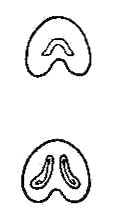|
Hardy Fern Home A. filix-femina resources All Ferns � Woodsiaceae �� Athyrium
�Other Genera
|
| Athyrium filix-femina | ||
Lady fern | ||
|
Etymology
From the Latin: filix, fern + femina, female or woman.
Description
Rhizome: short-creeping, forming an asymmetric clump, stout, scaly.
Frond: 120 cm high by 30 cm wide, deciduous, new fronds all summer, monomorphic, blade/stipe ratio: more than 1:1 to 2:1. Stipe: straw-colored above, base dark red-brown or black, swollen; in some forms very red, old stipes persistent, scales light to dark brown, linear- to ovate-lanceolate, 7--20 � 1--5 mm, vascular bundles: 2, curved, back-to-back, uniting to a U-shape above. Blade: 2-pinnate-pinnatifid, less and more also seen, elliptic to lanceolate, apex acuminate (see discussion below), herbaceous, yellow-green to bright green, rachis , costae, and costules glabrous or with glands or hairs. Pinnae: 20 to 30 pair, sessile to short-stalked, linear-oblong to lanceolate, apex acuminate; costae grooved above, V-shaped, continuous from rachis to costae to costules; margins serrate or lobed, blunt or acute at the tip; veins free, forking, not reaching the margin. Sori: straight, sometimes hooked at the far end, or horseshoe-shaped, at the base of the segments, indusium: elongate, toothed, to a veinlet, sporangia: brownish-gray to dark brown or yellow, maturity: midsummer to early fall. Dimensionality: sometimes the pinnae are perpendicular to the rachis, i.e., horizontal. Culture
Habitat: meadows, thickets, woodland, swamps.
Distribution: North America, Central America, South America, Europe, Asia.
Hardy to -30�C, USDA Zone 4, but given the distribution, the source is likely important.
Distinctive Characteristics
No more variable fern, as attested by several botanical and 200 horticultural forms, all of which are said to intergrade.
Synonyms
Polypodium filix-femina Linnaeus Athyrium asplenioides Michaux Athyrium filix-femina v. asplenioides Farwell Athyrium filix-femina v. michauxii Farwell Athyrium angustum Willdenow Asplenium michauxii Sprengel |
|
|
Notes
Compare It is suggested the lady fern may be confused with some wood ferns, but the oblong sori quickly put this to rest.
Variations The major variants in nature are: those with blades widest�just above�the base, stipes distinctly shorter than the blades, brown spores�(in NA, sometimes called the Southern Lady Fern, var. asplenioides) and blades widest near the middle, stipes nearly as long as the blades, yellow spores�(Northern Lady Fern, var. angustum). Given the variations, the European Lady Fern, var. filix-femina, is indistinguishable from var. asplenioides from�my viewpoint. The variant with reddish stipe and rachis is sometimes called forma rubellum.
Compare It is suggested the lady fern may be confused with some wood ferns, but the oblong sori quickly put this to rest.
Variations The major variants in nature are: those with blades widest�just above�the base, stipes distinctly shorter than the blades, brown spores�(in NA, sometimes called the Southern Lady Fern, var. asplenioides) and blades widest near the middle, stipes nearly as long as the blades, yellow spores�(Northern Lady Fern, var. angustum). Given the variations, the European Lady Fern, var. filix-femina, is indistinguishable from var. asplenioides from�my viewpoint. The variant with reddish stipe and rachis is sometimes called forma rubellum.

Athyrium filix-femina. Two vaguely j-shaped vascular bundles back to back at the stipe base, joined upwards at the back and top of the stipe. �Drawing from Ferns of Northeastern United States, Farida A. Wiley, 1936. |
